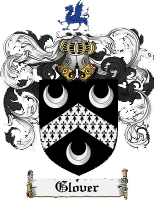He beareth a Sable, a Chevron Ermine, between three Crescents, Argent. The patent was granted by Wm. Camden, April 3, 1604, and descends to the family name of Glover
From a draft of James Bolan Glover V’s Colonial Governor William Glover and His Descendants, pages 3 and 4.
The Glover family has the distinction of having the oldest Coat-of-Arms on record. The “Glover’s Roll” is the oldest Roll-of-Arms (which it was called at that time) and was recorded in 1255 A.D.i Much later, a Glover Coat-of-Arms was recorded in Burke’s Heraldry, which was patented to Thomas Glover at London, England in the year 1604. The seat of that particular Glover family was at London and at Ashford, County Kent and Coventry, County Warwick. On March 4, 1577, a Coat-of-Arms was granted to a Glover family, which our Glover line has traditionally used and has for at least twelve generations; however, currently, we do not have line proof that the crest was granted to our direct ancestor. This crest is inscribed as a “Sable, a Chevron Ermine between three crescents argent.” Motto: Surgite, Lumen Adeste, taken from Isaiah 60:1 meaning, Arise, the light is here, or Time shall bring all things to light. Horace quotes, Time will bring to light whatever is hidden. One one witty Glover in-law from Walterboro, South Carolina interpreted the meaning as Get up, its morning!
The chevron symbolized protection as the roof-tree of a house. Ermines were furs of small animals and were used to adorn the royal robes worn by king and queen. This means dignity and rank. Argent (silver) signifies purity, peace, and justice. The crescent became prominent during the days of the crusades when making their sacred journey. The faithful pilgrims began wearing badges to identify friend from foe, and crescents were displayed on their robes and banners.
Being much used by the early Christians in this manner, on a Coat-of-Arms a crescent shows the family is of ancient lineage and often refers to them as being connected with the crusades and with visits to the holy land. The griffin’s head has reference to a fierce soldier in battle that fought and won over the enemy.
Variations are found in the Coats-of-Arms of the Virginia and Massachusetts Glovers, representing the Northern and Southern branches of the Glover families. The Southern Glovers adopted the less elaborate Coat-of-Arms, and some families incorporated their own crest. Dr. Francis Yonge Glover [F-16] of Charleston, South Carolina had a Coat-of-Arms signet ring made, having a slight variation, possibly incorporating the Yonge family’s crest into the Glover crest. Anne Glover [E-12] of Charleston, South Carolina married John Holmes, Esq. of John’s Island, South Carolina and their crest was diagonally split down the center, one half Glover, and the other half, Holmes. Many Glover homes have framed Coat-of-Arms adorning their walls, variations due to the different artists which paint them. The interpretation is the same for each of them, leading us to believe that there must be an ancient relationship between the different Glover families.
What is posted below is from a web search. Interesting, but cannot vouch for accuracy.
Glover Coat of Arms / Glover Family Crest
The surname of GLOVER was an occupational name from the Old French word Gaunter, meaning a maker or seller of gloves. The name was brought into England in the wake of the Norman Conquest of 1066. Surnames having a derivation from nicknames form the broadest and most miscellaneous class of surnames, encompassing many different types of origin.
The most typical classes refer adjectivally to the general physical aspect of the person concerned, or to his character. Many nicknames refer to a man’s size or height, while others make reference to a favoured article of clothing or style of dress. Many surnames derived from the names of animals and birds.
In the Middle Ages ideas were held about the characters of other living creatures, based on observation, and these associations were reflected and reinforced by large bodies of folk tales featuring animals behaving as humans.
Early records mention Gilbert le Glouere who was documented in the year 1250 in County Norfolk. William le Glouere was recorded in the year 1278 in County Surrey. Johannes Glouer of Yorkshire was listed in the 1379 Poll Tax of Yorkshire. William Baker and Elizabeth Glover were married at St. Michael, Cornhill, London in 1685.
Julia Glover (1779-1850) as an Irish comic actress born in Newry. She made her debut in 1789, and was sold by her father to Samuel Glover in 1798. In 1802 she appeared at Drury Lane, London, and became a leading lady of the London stage. Her second son, William Howard (1819-1875) was a composer and conductor.
At first the coat of arms was a practical matter which served a function on the battlefield and in tournaments. With his helmet covering his face, and armour encasing the knight from head to foot, the only means of identification for his followers, was the insignia painted on his shield, and embroidered on his surcoat, the draped and flowing garment worn over the armour
Most of the European surnames in countries such as England, Scotland and France were formed in the thirteenth and fourteenth centuries. The process had started somewhat earlier and had continued in some places into the 19th century, but the norm is that in the tenth and eleventh centuries people did not have surnames, whereas by the fifteenth century most of the population had acquired a second name.
The associated coat of arms is recorded in Sir Bernard Burkes General Armory. Ulster King of Arms in 1884
http://www.4crests.com/glover-coat-of-arms.html


